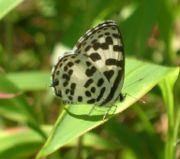Assam houses 60% of the world's butterflies
Of the 34 biodiversity hotspots in the world the Northeast is home to some rare breeds of flora and fauna that could hardly be seen anywhere in the globe. Of late, a study revealed here, found that the northern region can boast of about sixty per cent of the butterflies found in the entire globe.
Out of the world's15,000 odd butterflies, Assam houses more than 800 of the exotic winged variety. This is perhaps, largely due to the abundance of the entire North East India. The study also revealed that Kaziranga, famous for the unicornis, alone houses about 300 of the exotic species The worrying part is that there is a gradual decline due to deforestation and very less conservation activities. In the state of Assam, as over much of the Indian sub-continent, there is very little conservation activity directed towards butterflies. This decline in species, so typical of the third-world today, is an indication of the ongoing global environmental crisis, and if not checked will perhaps reach a point where downward trends can no longer be reversed.
Photo of Castalius rosimon used from Wikipedia
Random Stories
14 Aug 2017 - 9:54pm |
AT News Imphal
Convenor of the NSCN-IM Steering Committee, Rh Raising said that the August 3, 2015 Framework Agreement between the Government of India and the NSCN-IM is now at the final stage. “We are now...
7 Jul 2012 - 12:50am |
editor
Fresh trouble awaits Congress MLA Rumi Nath and her second husband. A legislator of her own party on Friday filed an FIR against Nath alleging that the couple had illegally entered his residence and...
28 Sep 2016 - 11:57pm |
AT News
Swagat Super-specialty Surgical Institute will conduct the next Saturday evening OPD at Guwahati Press Club for the benefit of its member-journalists along with their close relatives. Dr Amit Saha (...
21 Aug 2013 - 9:04pm |
AT News
JFA demands stern action against Dabholkar assassin Guwahati: Journalist Forum Assam (JFA) has expressed its utter dismay at the killing of Dr Narendra Dabholkar, a Maharashtra based editor and...
Other Contents by Author
The term 'biodiversity' denotes the variability of life forms on earth. Each little life form has its own place, duty and specific utility that balances Nature beautifully. As such, ecosystem stability is a compelling reason for preserving biodiversity. All living organisms are an integral part of the biosphere. They provide invaluable services like recycling of nutrients, replenishment of local climate, control of floods and control of pests. The intervention or erosion of biodiversity means imbalance of nature. The Indian tradition teaches us that all forms of life--human, animal and plant--are so closely interlinked that disturbance in one gives rise to imbalance in the other.
The...
Absence of exchange in summer time data continues to be a major concern in managing natural disasters in the Brahmaputra basin. In a media workshop on Climate Change effects in the Yarlung Zangbo/Brahmaputra Basin organised by the Third Pole Project and Internews Earth Journalism network in Kathmandu last week, Chinese scientist Dr Yang Yong said that a major disaster could have been averted ten years back had there been proper exchange of data in place. The scientist from the Hengduan Mountain Research Institute said that scientists from China predicted flash flood on the basis of rising of water level in Yigong Zangbo river (a large tributary of Tsangpo in the east of Tibet) and...
Women of Assam weave dreams in their looms... We very often echo Gandhiji’s famous line when we talk of our age-old, indigenous silk fabric of Assam. The golden thread, which is one of the strongest, generally has a long life and has a special place in the hearts of the Assamese. Silk production and weaving are intrinsically associated with Assamese culture. Muga, is produced by the Antheraea assama caterpillar. However, climate change and pollution now pose threat to the future of this national heritage.Last October (2010) the silk growers of Lakhimpur and Dhemaji (these are the two districts where Muga is produced in large scale) suffered heavy losses. All silkworms died out due to...





Comments
Pages
Add new comment